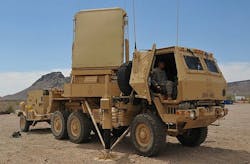Lockheed Martin to build new radar systems to help protect warfighters with counter-battery fire
ABERDEEN PROVING GROUND, Md., 7 Oct. 2015. Radar experts at Lockheed Martin Corp. will build and maintain AN/TPQ-53 radar systems for the U.S. Army to help protect deployed warfighters from rockets, mortar rounds, and artillery shells.
Officials of the Army Contracting Command at Aberdeen Proving Ground, Md., awarded two contracts last week to the Lockheed Martin Mission Systems and Training segment in Liverpool, N.Y., to build and maintain AN/TPQ-53 land-based radar systems.
The Lockheed Martin AN/TPQ-53 counter-fire target acquisition radar is designed to detect, classify, and track incoming rockets, artillery, and mortars, and pinpoint the location of the launchers to direct counter-battery fire.
The solid-state phased array radar works in either 360- or 90-degree modes, and is replacing the aging AN/TPQ-36 and AN/TPQ-37 medium-range radars now in the Army’s inventory.
The contracts, both announced on 30 Sept., involve procuring and maintaining AN/TPQ-53 radars. The first contract, for $85 million, is to purchase seven new AN/TPQ-53 IP radar systems. The second contract, for $33.4 million, is for interim contractor support services for all AN/TPQ-53 radar systems this year.
Mounted on a five-ton Oshkosh Defense battlefield truck, users can deploy the AN/TPQ-53 quickly to support heavy, medium and light forces. The target acquisition subsystem contains the radar on a truck and tows the power generator. A second truck carries an operations control shelter, backup power generator, and two additional soldiers.
Soldiers can operate the AN/TPQ-53 remotely using a laptop computer or from the equipped climate-controlled shelter. The radar’s software enables it to interface with the Army Battle Command Systems. Compared to currently deployed systems, the AN/TPQ-53 offers greater mobility, increased reliability and supportability, lower life-cycle cost, and reduced crew size, Lockheed Martin officials say.
On these contracts Lockheed Martin will do the work in Liverpool, N.Y.; and Moorestown, N.J., and should be finished by September 2017. For more information contact Lockheed Martin Mission Systems and Training online at www.lockheedmartin.com/us/mst, or the Army Contracting Command at Aberdeen Proving Ground at www.acc.army.mil/contractingcenters/acc-apg.

